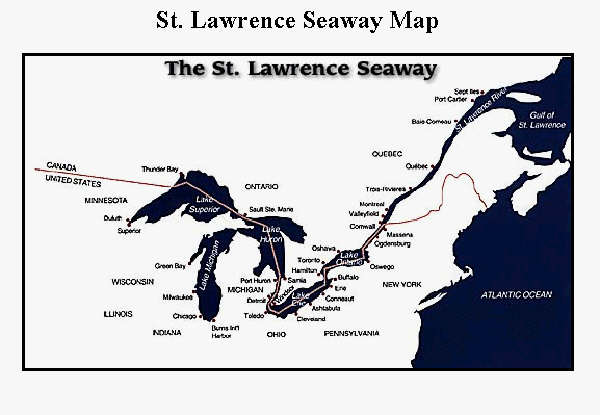 The seaway management corporation says its system of locks and channels is at about 60 per cent capacity and can accommodate much more traffic.
The seaway management corporation says its system of locks and channels is at about 60 per cent capacity and can accommodate much more traffic.
Seaway Shipping Increases 30 Percent From Overseas Steel Cargo Imports
Overseas Steel, New Products Push Waterborne Transport
October 30, 2006
By: Dave Rogers
Steel imports have boosted the amount of goods being shipped on the St. Lawrence Seaway by about 10 per cent from last year, and managers look to expanding the traffic as an alternative to highway-clogging trucks.
The seaway management corporation says its system of locks and channels is at about 60 per cent capacity and can accommodate much more traffic, particularly from growing markets in Asia.
The St. Lawrence Seaway Management Corporation says there were 31.9 million tons of goods transported over the seaway this year, as of the end of September. Tonnage involving overseas ocean vessels was up almost 30 per cent.
Andrew Bogora, spokesman for the seaway agency, said the overseas shipping increase is largely a result of steel imports from places such as eastern Europe.
Grain shipments were also up significantly, Bogora added, resulting from a large harvest and increased exports to places such as Europe, Africa and the Middle East.
Bogora noted the seaway management has been offering incentives to attract products like wind-turbine blades and associated parts, sugar, aluminum and synthetic gypsum. So-called "new cargoes" are at 400,000 tons so far this year, about double that of last year, Bogora said. This has resulted in an additional $1 million in revenue for the management agency, bringing the year-to-date revenue total to about $75 million.
The St. Lawrence Seaway Management Corporation is a non-profit Canadian agency that operates locks and passage systems throughout the St. Lawrence River and Great Lakes. It works in co-operation with the Saint Lawrence Seaway Development Corporation, owned by the U.S. government.
--- Advertisements ---


The agency is promoting marine travel as having minimal impact compared to other transportation modes in terms of energy usage, environmental impact and traffic congestion.
"We can almost double our capacity and almost no one will notice, and that's a very good thing because if you've got more freight moving and no one notices, I would suggest to you that means we're doing our job quite well," Bogora said.
The better fuel efficiency of marine travel, as compared to truck and rail transport, means reduced costs for customers and lower greenhouse-gas emissions, Bogora said. He said boats can transport goods with twice the fuel efficiency of trains and eight to 10 times that of transport trucks.
The seaway management corporation is stepping up inspection of ballast water on ships to guard against foreign marine life that has made its way into North American waterways by ocean vessels, resulting in an adverse impact on domestic animal and plant species.
An estimated 50,000 foreign species have invaded the U.S. in the past 30 years, including 5,000 plants such as purple loosestrife and phragmites.###